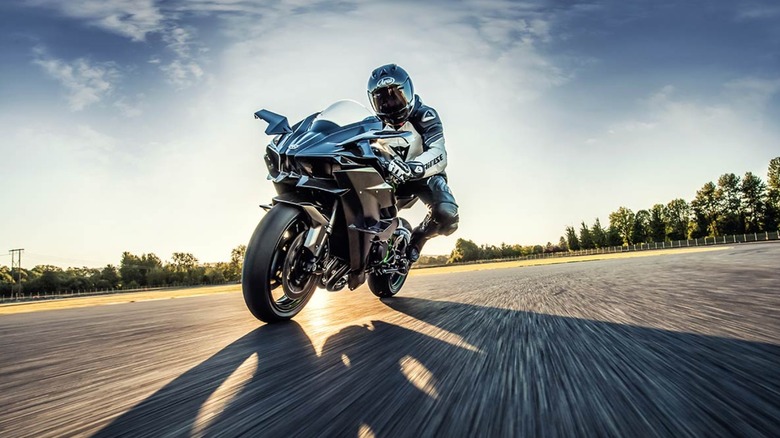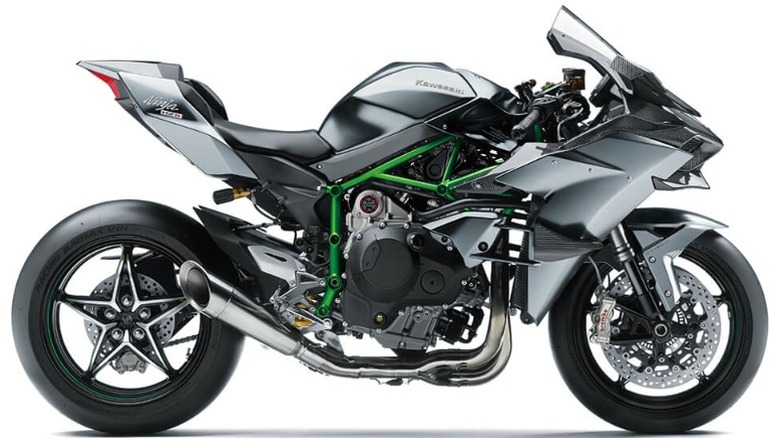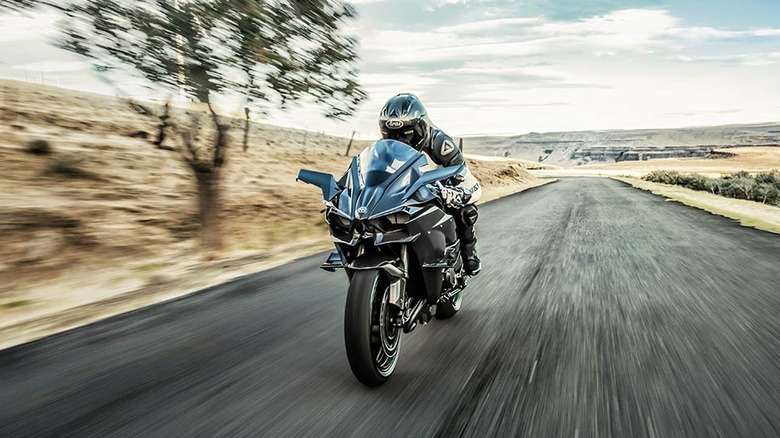Is The Kawasaki Ninja H2R Still The Fastest Motorcycle In The World?
If you're looking to beat your friends in a game of "whose motorcycle has the wildest stats" then you should head directly for the classified ads and start looking for a Kawasaki Ninja H2R. The H2R is the most expensive Kawasaki on sale today and one of the most expensive motorcycles you can buy from any manufacturer. It has an MSRP of $59,915 (including $815 destination fee), which is more than triple the cost of the supersport ZX-14R. That said, technically, you can't even buy a new Ninja H2R; all of Kawasaki's orders for 2025 have been filled. So why does the H2R cost so much? Probably because it was designed to be the fastest motorcycle on earth and it remains one of the fastest motorcycles ever built.
Back in 2016, Kawasaki sent a test rider out to see just how fast the H2R could go. Across the Osman Gazi Bridge in Turkey, test-rider and WorldSBK rider Kenan Sofuoglu set a production bike world record, going from zero to 400 km/h (248.5 miles per hour) in just 26 seconds. The top speed beat his previous record of 391 km/h and required Sufoglu to wear a specially designed race suit. And yes, in terms of production bikes, it's still the fastest motorcycle in the world, well ahead of bikes like the Aprilia RSV4 Factory 1100 and the Honda CBR1000RR-R Fireblade SP we recently tested (though not at top speed).
Ingredients in the recipe for speed
The H2R is powered by a 998cc inline four-cylinder engine with a supercharger added on for good measure, cranking out 321.5 hp and 121.5 lb-ft of torque. All that power is provided in a machine that weighs just 476.3 pounds. That's 0.67 horsepower per pound; to put that into perspective, the record-breaking C8 Corvette ZR1, with its twin-turbocharged 1,064-hp V8, offers just 0.27 horsepower per pound — less than half the power-to-weight ratio of what the H2R is offering.
Other Ninja H2 models in the Kawasaki lineup use a less-powerful version of the supercharged four-cylinder engine, but none of them get the same top-speed treatment or horsepower that the H2R does. The standard H2, for example, has a version of the same engine, but it only puts out 239.6 hp and 104.9 lb-ft of torque. Those are still extreme numbers, but nowhere near the purpose-built H2R. The H2R also gets slick tires, which the standard H2 does not. Other H2 models like the touring-focused H2 SX SE and the naked street-fighter Z H2 SE get a bit less horsepower, although they're still formidable bikes that offer just as much performance as many of the superbikes in their respective classes. They're also significantly less expensive than the H2R; the H2 SX has an MSRP of $29,915 and the Z H2 checks in at $22,515 (both including $815 destination fee). That's expensive, but a relative bargain for the supercharged powertrain.
What it takes to go 248 mph
The H2R is brutally powerful, and being able to keep the throttle open long enough to achieve a production-motorcycle record on a bridge takes an intense level of commitment to the task at hand. But more than just big displacement, a supercharger, and sheer will, there are some specific features packed into the H2R that allow it to go that fast. As mentioned, the slick tires and Sofuoglu's special suit were part of the process, providing grip on the ground and reducing drag. Specialized, fully-adjustable Öhlins suspension helps get the ride right, while cast aluminum wheels, specially designed for the H2R, make sure unsprung weight is kept to a minimum.
Naturally, the H2R also comes with an Öhlins steering damper that stabilizes the front end at high speeds. Carbon fiber bodywork keeps the H2R as light as possible while reducing resistance and creating the proper downforce — and at speeds over 200 mph, keeping the bike on the ground is just as important as anything else. These solutions helped the H2R achieve a record at Bonneville, too, with an average speed of 209.442 mph.


